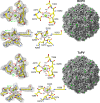Birds of a feather flock together: structural characterization of red-crowned crane and turkey aveparvoviruses
- PMID: 40607800
- PMCID: PMC12282197
- DOI: 10.1128/jvi.00110-25
Birds of a feather flock together: structural characterization of red-crowned crane and turkey aveparvoviruses
Abstract
The parvoviruses have non-enveloped T = 1 icosahedral capsids that are ~25 nm in diameter, which package linear single-stranded DNA and infect a wide range of hosts. To date, parvoviruses affecting birds have been identified in two genera: Ave- and Dependoparvovirus, and no capsid structures have been determined for any member of Aveparvovirus. This study investigates two bird viruses of this genus: red-crowned crane parvovirus (RCPV) and turkey parvovirus (TuPV). While the pathogenicity of RCPV is currently unknown, TuPV has been associated with gastrointestinal diseases, especially in juvenile birds. High-resolution structures of the RCPV and TuPV capsids were determined by cryo-electron microscopy at a resolution of 2.66 Å and 2.35 Å, respectively. A structural comparison of the RCPV and TuPV capsids shows that they exhibit many conserved features, such as a channel at the five-fold symmetry axis and surface depressions at the two-fold axis, as previously observed in parvoviruses from other genera. However, major structural differences were observed at the three-fold axes, with both RCPV and TuPV displaying recessed protrusions. In addition, terminal sialic acid was identified as a potential glycan receptor for RCPV. This study extends the architectural portfolio of structural parvovirology and will provide insights into parvoviral diversity and characterization of these viruses.IMPORTANCEThis study presents the capsid structures of two aveparvoviruses, red-crowned crane parvovirus (RCPV) and turkey parvovirus (TuPV), extending the structural repertoire of the Parvoviridae. While the pathogenicity of RCPV is unknown, the red-crowned cranes are among the rarest crane species. To date, very few virological studies have been conducted for this rare avian species, and understanding their virome could contribute to conservation efforts. Additionally, several studies have previously suggested that TuPV is associated with cases of enteric disease syndrome. To date, no commercial antivirals or vaccines are available for TuPV. The structural characterization of its capsid may contribute toward the development of a treatment to control the spread of infection.
Keywords: Aveparvovirus; RCPV; TuPV; capsid; cryo-EM; parvovirus; pathogen; red-crowned crane; turkey.
Conflict of interest statement
The authors declare no conflict of interest .
Figures







References
-
- Samantha JL, Florian D, Paul D. 2024. A Brief History of Bird Flu. Philosophical Transactions of the Royal Society B: Biological Sciences. Retrieved 1 Jun 2024. doi: 10.1098/rstb.2018.0257 - DOI
-
- Susan FC. 2023. ICTV virus taxonomy profile: parvoviridae. Microbiology Society. Retrieved 16 Feb 2023. doi: 10.1099/jgv.0.001212 - DOI
MeSH terms
Substances
Grants and funding
LinkOut - more resources
Full Text Sources

